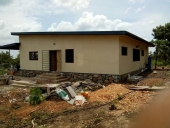Hi all, I'm in Central Texas, and I'm thinking about building a
raised bed for growing all sorts of edibles. The end goal is actually a pretty large system of growing beds, but first I have a more general question.
When I think about the materials to be used, I'm not sure what's best.
Wood will rot and need to be replaced (which could cause the soil inside to spill out), and I don't want to use stone or brick (costs a lot, don't know how to apply mortar, and don't want to dry-stack since I'm in scorpion country). I love the look and concept of rammed earth, but from what I've read here and elsewhere I don't know whether or not it would be an appropriate material. Basically I need something relatively inexpensive, with virtually zero maintenance, and will be extremely long-lasting. Rammed earth seems to fit the bill, but here are my questions.
For example, once I let the walls dry out, will it be okay to fill the beds with 90%+ compostable (moist) material, or would that degrade the walls? These beds would be out in the open, so what protection would they need to be given on the top (and bottom, for that matter) to prevent erosion?
Also, the plan I have is to have some beds be 3 feet high, some 2 feet, and a single one-footer, with the walls about 6 inches thick. Does that even make sense structurally with rammed earth?
Many thanks in advance for your advice!
---Brian






